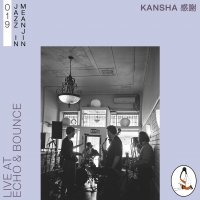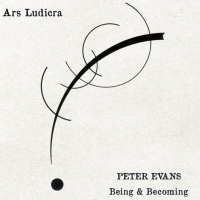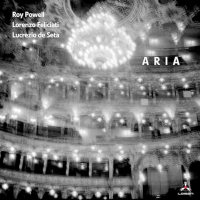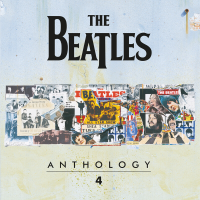Home » Jazz Articles » Multiple Reviews » Brian Eno: Ambient Forefather
Brian Eno: Ambient Forefather
 When Roxy Music keyboardist Brian Eno and King Crimson guitarist Robert Fripp first put together two Revox tape recorders in 1973, making it possible to build layer-upon-layer of sound, the result was a kind of music the likes of which had never been heard before. On the landmark recordings No Pussyfooting ('73) and Evening Star ('75) Fripp created a multitude of guitar loops over which he could then add improvisations, the result being something that was trance-inducing yet, at the same time, demanding of attention; music which could either stand at the forefront of the listener's consciousness or become a kind of aural wallpaper, a backdrop which could ultimately become part of the listener's overall environment.
When Roxy Music keyboardist Brian Eno and King Crimson guitarist Robert Fripp first put together two Revox tape recorders in 1973, making it possible to build layer-upon-layer of sound, the result was a kind of music the likes of which had never been heard before. On the landmark recordings No Pussyfooting ('73) and Evening Star ('75) Fripp created a multitude of guitar loops over which he could then add improvisations, the result being something that was trance-inducing yet, at the same time, demanding of attention; music which could either stand at the forefront of the listener's consciousness or become a kind of aural wallpaper, a backdrop which could ultimately become part of the listener's overall environment. Ultimately Fripp and Eno would diverge with this premise; Fripp, moving more and more into layers of sound he would first call Frippertronics and later Soundscapes; textures that could be used either on their own or as sonic backdrops for other more structured compositions. Eno, on the other hand, took the concept in a different direction, one that would, on one hand, appear more simplified while, on the other, actually have a foundation in concepts that would become increasingly complex. This direction was rooted in a circumstance where Eno, following a minor accident, found himself confined to bed rest with a rudimentary and not altogether-functioning stereo system playing a record of 18th Century harp music. The music, rather than dominating Eno's consciousness, was more a part of the general ambience of the room; no more or less a part of the sounds that invaded Eno's perception than drops of rain on a window pane. This experience gave Eno the idea which would ultimately become inarguably his most significant and enduring musical concept—Ambient Music; a style which would set the stage for many imitators in subsequent years but, with a purity of intent and execution, often copied but never imitated.
Over the course of four records— Discreet Music ('75), and his Ambient Series recordings Ambient 1: Music for Airports ('78), Ambient 2: The Plateaux of Mirror ('80) with pianist Harold Budd and Ambient 4: On Land ('82), Eno would introduce this new concept of a music that, rather than demanding the listener's undivided attention, would become a part of the overall aural landscape of the listener's experience. At least that was Eno's intention. The more significant truth of the matter is that while these recordings, and those that followed, including Apollo ('83), Thursday Afternoon ('85') and Neroli ('93), could indeed be non-invasive audioscapes, soundtracks to landscapes imaginary and real, they could also be experienced as more traditional music—listened to and appreciated for their stark simplicity and, in many cases, lyrical elegance.
With Astralwerks' recent reissue of beautifully remastered digipak editions of Eno's first four Ambient Music records, which bring out a sonic clarity previously only heard in the control room of the studio, now is as good a time as any to revisit these landmark albums, examine their individual purposes and the concepts that distinguished them while, at the same time, bringing them together as a conceptual whole. Note that Ambient 3: Days of Radiance is omitted from this series of reissues as, while it is produced by Eno, it is more accurately a record of music by hammered dulcimer player Laraaji.
 Brian Eno
Brian EnoDiscreet Music
Virgin/Astralwerks 7243 8 66493 2 4
1975; Reissued 2004
The back cover of Discreet Music has a diagram that explains, in technical terms, how Eno was able to take two simple synthesizer themes and, by feeding them through two tape recorders, equalization and an echo unit, build a thirty-minute piece of graceful beauty. But this description ultimately trivializes the significance of the composition. "Discreet Music" suits its name by being an unpretentious and unobtrusive work that builds from nothing and, ultimately, ends in nothing as well. But what lies between these two non-entities is tranquility made sonic. Rooted in the minimalist work of composers like Philip Glass, Steve Reich and, in particular, Terry Riley, "Discreet Music" works on repetition; but instead of being based around mathematical combinations of musical phrases, Eno's two themes intertwine more randomly, all the while creating immensely pleasing harmonies. Eno asserts that his concept is all to do with eliminating or, at the very least, minimizing the interference of the performer, making music that "could be listened to and yet could be ignored'perhaps in the spirit of Satie who wanted to make music that could 'mingle with the sound of the knives and forks at dinner.'"
And, truthfully, Eno succeeds at creating his first piece of truly Ambient Music. "Discreet Music" almost works best at low volumes, where it is only a part of the listener's complete aural experience. Still, when played at a higher volume, where it becomes invasive in the listener's consciousness, it becomes a hypnotic experience, the mind following one melodic path only to be gently interrupted and prodded in another direction as harmonies are gradually introduced, shifted and reiterated.
The other pieces on Discreet Music are variations on Pachelbel's Canon in D Major, but also treated with interesting premises for examining this distinctly dramatic and romantic music. Small sections of the score are used as starting points and, in a minimalist fashion, used to create overlays that enhance the simple phrases in ways not previously imagined. On "Fullness of Wind," for example, each player decreases his/her tempo gradually; the speed determined by the pitch of the instrument—the lower the register of the instrument, the more gradual the decrease. Similar to Terry Riley's groundbreaking In C , what becomes evident as the players slow down their parts is how, remarkably, new and gorgeous harmonies emerge. With stronger melodies and more striking dynamics, the three Pachelbel treatments are inherently more intrusive than "Discreet Music," but no less compelling.
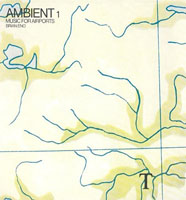 Brian Eno
Brian EnoAmbient 1: Music for Airports
Virgin/Astralwerks 7243 8 66495 2 2
1978; Reissued 2004
No single suite of music defines Eno's concept of Ambient Music as well as the first of his four Ambient Series recordings, Ambient 1: Music for Airports. An alternative to the background Muzak played at shopping malls, airports, etc., where little consideration is given to the actual environment in which this musical wallpaper is played and, consequently, the emotional impact it has on its listeners, Eno's concept is to create pieces with specific feelings, specific ambiences in mind. Rather than being used to blanket or cover the extant sounds of the environment, Eno's concept is, instead, to find musical ways to enhance them. Again, the concept is to make music that can operate at a variety of levels or, as Eno puts it, "it must be as ignorable as it is interesting."
The four pieces on Ambient 1: Music for Airports , while sharing a similar concept, distinguish themselves as four distinct pieces of music. "1/1" is based around the simple loop of an acoustic piano phrase played by Robert Wyatt, ex-Soft Machine drummer and multi-instrumentalist. Eno augments the phrase with gentle washes of synthesizer pads as the piano phrase is looped and repeated with varying pauses between phrases creating a sense of unbalance that could be disturbing but, instead, develops a gentle and pleasing undulation. While the repeated phrase becomes completely familiar its subtle unpredictability retains a level of interest that makes it succeed as a piece of music that can work at all levels of consciousness.
The other pieces, using voice, piano, brass synthesizer and other gentle effects, succeed equally at defining an environmental atmosphere that subtly and almost insidiously pacifies the listener. Imagine being in an airport where, rather than hearing some irritatingly lacklustre version of some popular tune become almost painfully stuck in one's head, pleasing and soothing sounds—discernable if one concentrates hard enough but, for the most part, just below the surface of one's consciousness—are constantly in play; melodies that, rather than grabbing the attention, become simply a part of the overall experience.
An interesting testament to the success of Music for Airports is that not only was it used as a backdrop in a number of airports including New York's La Guardia, but that the New York new music ensemble Bang on a Can would ultimately take the album and create an actual score from whence there was none, and re-record the album, thus proving its endurance, not only as a piece of ambient audioscape, but as a captivating piece of music as well.
 Harold Budd/Brian Eno
Harold Budd/Brian EnoAmbient 2: The Plateaux of Mirror
Virgin/Astralwerks 7243 8 66497 2 0
1980; Reissued 2004
Composer Harold Budd had already been on the avante garde scene for about a decade, creating unusual pieces such as a 24-hour composition for solo gong; but rather than create music that was angular and jarring, his methodology, from inception, was to write music, then remove all the notes he didn't like, the intention being to create "eternally pretty music." He had already worked with Brian Eno on his 1978 recording d'but The Pavilion of Dreams with Eno in the producer's chair, but on Ambient 2: The Plateaux of Mirror theirs is a true collaboration, with Eno using all manner of effects to treat Budd's almost na've piano etudes, the result being an album of stark simplicity and, paradoxically, rich beauty.
It's a marriage made in heaven. Eno creates lush ambient audioscapes over which Budd improvises. The result is an album which, like Discreet Music and Music for Airports , can be listened to on a variety of levels. When played back at a low volume the record becomes part of the overall landscape of the listener's experience, adding a calming, pacifying influence to whatever the listener might be doing. Played at more traditional listening volumes, Budd's improvisations become more dominant, yet never overly intrusive. Budd's ability to evoke moods from gentle joy to brooding melancholy out of a minimal number of carefully-chosen notes is extraordinary, and The Plateaux of Mirror , along with The Pavilion of Dreams , signal the beginning of a simple yet compelling musical concept that Budd continues to explore to this day.
Eno utilizes a variety of studio effects to create the dream-like ambience on The Plateaux of Mirror , yet somehow the result feels completely organic. And that, in fact, is what makes the entire Ambient Series so important; it demonstrates the ability to create environmentally unaffected textures that may only be possible to construct in the studio, but once complete, are capable of becoming a fundamental part one's natural surroundings.
 Brian Eno
Brian EnoAmbient 4: On Land
Virgin/Astralwerks 7243 6 66499 2 8
1982; Reissued 2004
For the last in Eno's initial series of Ambient recordings, he eschews, for the most part, the use of conventional instruments and melodic concepts. Instead he utilizes found sounds—indigenous music, mechanical sounds, the sound of chains and stones and more, to create an album of time and place. Ambient 4: On Land is even more about experience and less about conventional listening; music that is meant more to be felt than heard. Music that, through its combinations of found sounds processed and placed in well-considered places in the stereo image—this is a recording that is best listened to in headphones—evokes strong imagery of places real and imagined.
Eno even references earlier works, extracting bits and pieces and subsuming them into a new whole. Eno compares this process to composting, "converting what would otherwise have been waste into nourishment." While one might argue Eno's calling any of the source material for this recording waste, he clearly has a vision—although to call it merely a musical vision might undervalue it—that involves drawing sound from a variety of sources, from the inherently musical to the less traditional, and shaping it into deeply provocative textures. Eno may never have been to "Lantern Marsh," located near where he grew up in East Anglia, but he has a vivid impression of what it must be like and, consequently, fashions a piece that, like the rest of the works on On Land , is intensely visual.
Eno would continue to investigate the potential of sound as a part of the atmosphere, including the ability to investigate more extended pieces made possible by the time-liberating capabilities of the compact disc; but on these four early experiments in Ambient Music he has fashioned four distinctly different aspects of the same concept. From the trance-like nature of Discreet Music to the more soothing background of Music for Airports ; from the lyrical beauty of The Plateaux of Mirror to the more uniquely visual aspects of On Land , Eno truly broke new ground with each recording, creating a style of music that would inspire countless other artists, although none would ever achieve such innocent purity and vivid imagery.
Related Article: Brian Eno: The Soundtracks Reissues
Tags
PREVIOUS / NEXT
Support All About Jazz
 All About Jazz has been a pillar of jazz since 1995, championing it as an art form and, more importantly, supporting the musicians who make it. Our enduring commitment has made "AAJ" one of the most culturally important websites of its kind, read by hundreds of thousands of fans, musicians and industry figures every month.
All About Jazz has been a pillar of jazz since 1995, championing it as an art form and, more importantly, supporting the musicians who make it. Our enduring commitment has made "AAJ" one of the most culturally important websites of its kind, read by hundreds of thousands of fans, musicians and industry figures every month.











